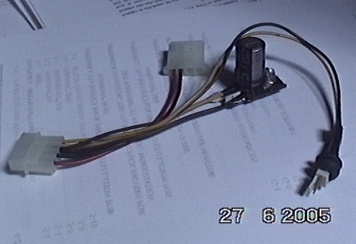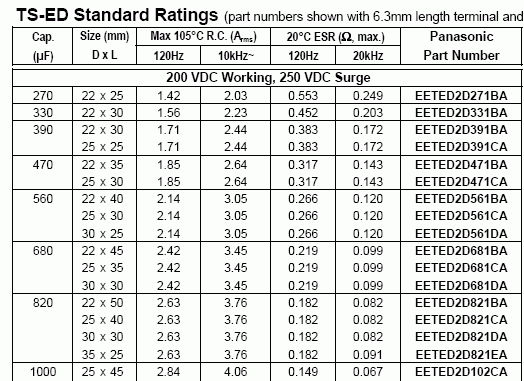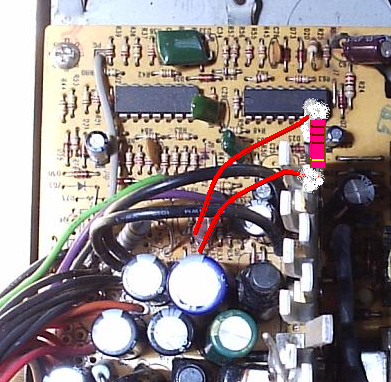Re: Eurocase 350W PSU
Btw, interesting topic brought by trodas. I can't resist not to polute the thread I wonder if it should be moved to PSu section.. I search this thread yesterday and can only found it by tracking my own post
I wonder if it should be moved to PSu section.. I search this thread yesterday and can only found it by tracking my own post 
Trodas, That 2000uF is probably a bit low for the pi filter (configuration of cap - coil - cap) and true that most of the cheap PSU of 300W-360W i have opened only have 2000uF total in paralel for each rail. But they work. Come to think about it again, their only true wattage probably are only 150-250W range. Now if you want to know what the (relatively) high quality PSU of 300W, i have a 300W old Fortron (FSP300-60BT) with 4700uF single cap each on 5v and 3.3v. The coils on the pi filter are larger AWG, impossible to find on those cheap PSU.
So, it appears that even the true 300W PSU has 4700uF on their rails except for the 12v (1000uF + 1650uF). It's old atx spec though, low requirement on 12V. On every cheap PSU I recap because of badcaps or just for the badcaps prevention, i replace those 1000uF with at least 1500uF Sanyo WG (preferably Nichi HE 3300uf 16v 12.5mm), or keep using 1000uF but this time using good old Rubycon ZL (10mm 1000uF 16v $0.15). They migh not be non-aquaous caps but they are at least 4000h 105C caps i feel safe to use.
So i think what ideal for the 300W (cheap) PSU recaping is:
3.3v -> 2 x 2200uF (100% upgrading)
5v -> 2 x 2200uF (100% upgrading)
12v -> 2 x 1500uF (50% upgrading)
BTW in more advanced/higher wattage PSU like on my Tt 480W, i found:
3.3v -> 2 x 3300uF
5v -> 2 x 3300uF
12v -> 1000uF + 2200uF
Note that they are all ATX v1.3
On Silverstone 360W ATX v2.01 :
3.3v -> 2 x 3300uF
5v -> 2 x 2200uF
12v -> 1000uF + 2200uF
With the stock caps i have, for the modern PSu (V2.x ATX), i can recap them as follow:
3.3v -> 2 x (3300uF 6.3v 10mm) (0% upgrading)
5v -> 2 x (3300uF 6.3v 10mm) (50% upgrading)
12v -> 2 x (3300uF 16v 12.5mm) (100% upgrading)
Or if i can't squeeze the space, i use 1500uF 16v 10mm caps for 12v rails as it is the bigest capacitance i can get in 16v 10mm caps. They are Sanyo WG, so their ripple current rate are just perfect. To compensate lower capacitance, i use higher uF/lower ESR caps on mobo and vga cards (jap brands). For hd or optical drive that need 12v rail, i don't sure if LESR or low ripple is more important factor than the capacitance for such constant load in the line, but IMO anything larger than 2x1000uF on secondary side caps PSU (12v rail) is safe. Anything but taiwan/chinese crap caps. But if you use more than six hardisk then you may think you need a capacitor bank for the 12v rail (or simply add a second PSU). Do you ever read about power lead made by OCZ? Many will wonder about its (effective) functionality but i think i's a very smart idea (caps, ceramic caps, and iron core on the end of mollex connector).
(or simply add a second PSU). Do you ever read about power lead made by OCZ? Many will wonder about its (effective) functionality but i think i's a very smart idea (caps, ceramic caps, and iron core on the end of mollex connector).
I made it a year ago (a laughable design, only caps, led, and small pcb). I lost interest before i attemp to make a better circuit.

Trodas, i can only found 2200uF 16v 10mm in Panasonic FK. If the PSU is for my equipment only probably i can tolerate using those hi spec Samxon. But that hi spec and small dimension samxon caps just scared me if it for using in PSU, too much water in it maybe? (It's the question remains to be answered). The teapo SC 2200uF 16v 10mm usually found on the PSu is even low spec (1.7 mA permissible ripple currrent). If space is not a problem, using 12.5mm ZL, YX*, FC, HE, LX*, is preferable. (Dont say they are garbage just because ther are worse spec than MCZ or GA
(It's the question remains to be answered). The teapo SC 2200uF 16v 10mm usually found on the PSu is even low spec (1.7 mA permissible ripple currrent). If space is not a problem, using 12.5mm ZL, YX*, FC, HE, LX*, is preferable. (Dont say they are garbage just because ther are worse spec than MCZ or GA  ).
).
For the input filters caps, so far I never found Jamicon or Hitachi. But if they are Teapo LXK i would keep them. IME they are proof to life long at least 3 years. But if they are another cheap taiwanese/chinese brand with the same rating but suspiciously smaller dimension compared to their japanase counterpart, i feel the urge to remove them, although i dont think bigger dimension will justify it will last long or immune to heat. What i think is that it's the electrolyte formula and perfect manufacturing that play the bigest role in here. What gonzo said about this is very informative (that large caps made by cheap brand should have fairly good quality)
Weird, at that spec (105C 120Hz TS-ED) i see it has 2420mA allowable ripple and 0.219 ohm ESR (20C 105C). Page six where? Maybe on this?

But they are larger can and so they are blocking the airflow greater.  But i agree they are much higher heat resistance (comparison within the same series and elct formula/technology).
But i agree they are much higher heat resistance (comparison within the same series and elct formula/technology).
trodas, i think it will be better to replace the heatsink directly with that copper than just mounting that copper on the heatsink. Or you may replace with a better performance (custom made) heatsink. Once you try it, you may realize it's not a delicate job. What i done is also isolating the chip/diode totaly from the heatsink with good insulator such shinetsu thermal paste/glue (remove also the thermalpad). I could be wrong but from my experience it's not necessary to make the heatsink as a ground path for the chip/diodes. i cant explain but i never found any problem with it.
The PC case usually allow wider PSU case, so you may make a totally new PSU case from thick copper that connected to primary and secondary heatsink so it will make a very big passive heatsink. Be carreful as you may send AC voltage to the system. (continuity tester is our saviour).
(continuity tester is our saviour).
Dont you have an LCR meter or at least DMM with capacitance measuring ability?
The best time to recap is when the hardwares still new. It will be better than new. But Im not suggesting you to void the warranty. If you have dual (two same hardware), recap one and see what the different after several years. That's what i lately do, i'll have something to write about it in the future. 
Sometime bad caps do not instantly make a bad hardware, it depends on the quality of the hardware design. I wait 4-5 month until i recap my epox board with 9 doomed gsc caps (see my GSC pics on the hall of shame thread), the board was still functioning fine (read: folding) before then. IIRC a little bit instability here and there but it never shutdown suddenly when it was folding..
Isn't that job already taken by the input filter (or by AC filter, EMI filter, or such)?
I even make a soft startup circuit between the plug wall and the PSu in my boring time. That's only to make me understand how the input filter works.
----
Some question im just too afraid to ask:
Will a fairly large amount of capacitance in secondary side of a PSU sustains/tortures the scottchkies? If yes, to what degrees (if not, why)? Will it need a change in coils requirement (both big and small coils in the secondary)?
Are those dummy resistor (low ohm high wattage) also responsible for discharging those secondary caps immediately after the system shut off? BTW they are so hot i need to mounted it on the hs, otherwise it will burn the pcb.

Btw, interesting topic brought by trodas. I can't resist not to polute the thread
 I wonder if it should be moved to PSu section.. I search this thread yesterday and can only found it by tracking my own post
I wonder if it should be moved to PSu section.. I search this thread yesterday and can only found it by tracking my own post 
Trodas, That 2000uF is probably a bit low for the pi filter (configuration of cap - coil - cap) and true that most of the cheap PSU of 300W-360W i have opened only have 2000uF total in paralel for each rail. But they work. Come to think about it again, their only true wattage probably are only 150-250W range. Now if you want to know what the (relatively) high quality PSU of 300W, i have a 300W old Fortron (FSP300-60BT) with 4700uF single cap each on 5v and 3.3v. The coils on the pi filter are larger AWG, impossible to find on those cheap PSU.
So, it appears that even the true 300W PSU has 4700uF on their rails except for the 12v (1000uF + 1650uF). It's old atx spec though, low requirement on 12V. On every cheap PSU I recap because of badcaps or just for the badcaps prevention, i replace those 1000uF with at least 1500uF Sanyo WG (preferably Nichi HE 3300uf 16v 12.5mm), or keep using 1000uF but this time using good old Rubycon ZL (10mm 1000uF 16v $0.15). They migh not be non-aquaous caps but they are at least 4000h 105C caps i feel safe to use.
So i think what ideal for the 300W (cheap) PSU recaping is:
3.3v -> 2 x 2200uF (100% upgrading)
5v -> 2 x 2200uF (100% upgrading)
12v -> 2 x 1500uF (50% upgrading)
BTW in more advanced/higher wattage PSU like on my Tt 480W, i found:
3.3v -> 2 x 3300uF
5v -> 2 x 3300uF
12v -> 1000uF + 2200uF
Note that they are all ATX v1.3
On Silverstone 360W ATX v2.01 :
3.3v -> 2 x 3300uF
5v -> 2 x 2200uF
12v -> 1000uF + 2200uF
With the stock caps i have, for the modern PSu (V2.x ATX), i can recap them as follow:
3.3v -> 2 x (3300uF 6.3v 10mm) (0% upgrading)
5v -> 2 x (3300uF 6.3v 10mm) (50% upgrading)
12v -> 2 x (3300uF 16v 12.5mm) (100% upgrading)
Or if i can't squeeze the space, i use 1500uF 16v 10mm caps for 12v rails as it is the bigest capacitance i can get in 16v 10mm caps. They are Sanyo WG, so their ripple current rate are just perfect. To compensate lower capacitance, i use higher uF/lower ESR caps on mobo and vga cards (jap brands). For hd or optical drive that need 12v rail, i don't sure if LESR or low ripple is more important factor than the capacitance for such constant load in the line, but IMO anything larger than 2x1000uF on secondary side caps PSU (12v rail) is safe. Anything but taiwan/chinese crap caps. But if you use more than six hardisk then you may think you need a capacitor bank for the 12v rail
 (or simply add a second PSU). Do you ever read about power lead made by OCZ? Many will wonder about its (effective) functionality but i think i's a very smart idea (caps, ceramic caps, and iron core on the end of mollex connector).
(or simply add a second PSU). Do you ever read about power lead made by OCZ? Many will wonder about its (effective) functionality but i think i's a very smart idea (caps, ceramic caps, and iron core on the end of mollex connector).I made it a year ago (a laughable design, only caps, led, and small pcb). I lost interest before i attemp to make a better circuit.
Trodas, i can only found 2200uF 16v 10mm in Panasonic FK. If the PSU is for my equipment only probably i can tolerate using those hi spec Samxon. But that hi spec and small dimension samxon caps just scared me if it for using in PSU, too much water in it maybe?
 (It's the question remains to be answered). The teapo SC 2200uF 16v 10mm usually found on the PSu is even low spec (1.7 mA permissible ripple currrent). If space is not a problem, using 12.5mm ZL, YX*, FC, HE, LX*, is preferable. (Dont say they are garbage just because ther are worse spec than MCZ or GA
(It's the question remains to be answered). The teapo SC 2200uF 16v 10mm usually found on the PSu is even low spec (1.7 mA permissible ripple currrent). If space is not a problem, using 12.5mm ZL, YX*, FC, HE, LX*, is preferable. (Dont say they are garbage just because ther are worse spec than MCZ or GA  ).
). For the input filters caps, so far I never found Jamicon or Hitachi. But if they are Teapo LXK i would keep them. IME they are proof to life long at least 3 years. But if they are another cheap taiwanese/chinese brand with the same rating but suspiciously smaller dimension compared to their japanase counterpart, i feel the urge to remove them, although i dont think bigger dimension will justify it will last long or immune to heat. What i think is that it's the electrolyte formula and perfect manufacturing that play the bigest role in here. What gonzo said about this is very informative (that large caps made by cheap brand should have fairly good quality)
Panasonic TS-ED 680uF 200V r22x45 Load life is 3000h but 105°C and ripple - see page SIX on TWO paged document - so, ripple is unknown and that is all the decision problem I have now...
And do you rate this as overkill even if you include the fanless operation?
I mean - bigger cap dissipate heat better - because it is bigger
I mean - bigger cap dissipate heat better - because it is bigger
trodas, i think it will be better to replace the heatsink directly with that copper than just mounting that copper on the heatsink. Or you may replace with a better performance (custom made) heatsink. Once you try it, you may realize it's not a delicate job. What i done is also isolating the chip/diode totaly from the heatsink with good insulator such shinetsu thermal paste/glue (remove also the thermalpad). I could be wrong but from my experience it's not necessary to make the heatsink as a ground path for the chip/diodes. i cant explain but i never found any problem with it.
The PC case usually allow wider PSU case, so you may make a totally new PSU case from thick copper that connected to primary and secondary heatsink so it will make a very big passive heatsink. Be carreful as you may send AC voltage to the system.
 (continuity tester is our saviour).
(continuity tester is our saviour).
And I never measured it, so how can I know if they lost some capacity?
Still think that in case of knowingly bad caps is waiting a good idea?

Sometime bad caps do not instantly make a bad hardware, it depends on the quality of the hardware design. I wait 4-5 month until i recap my epox board with 9 doomed gsc caps (see my GSC pics on the hall of shame thread), the board was still functioning fine (read: folding) before then. IIRC a little bit instability here and there but it never shutdown suddenly when it was folding..
Now the filtering. After my bad experience with the PSU I wanted to make sure that nothing bad will happen again. So, what should I do? Block (bridge) each of the big output caps with 10uF 16V ceramics?
Will that help enought? Or should I also add in parallel 100nF 16V ceramics to this?
Will that help enought? Or should I also add in parallel 100nF 16V ceramics to this?
I even make a soft startup circuit between the plug wall and the PSu in my boring time. That's only to make me understand how the input filter works.
----
Some question im just too afraid to ask:
Will a fairly large amount of capacitance in secondary side of a PSU sustains/tortures the scottchkies? If yes, to what degrees (if not, why)? Will it need a change in coils requirement (both big and small coils in the secondary)?
Are those dummy resistor (low ohm high wattage) also responsible for discharging those secondary caps immediately after the system shut off? BTW they are so hot i need to mounted it on the hs, otherwise it will burn the pcb.










Comment